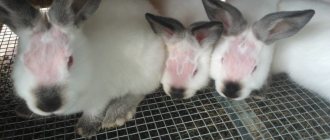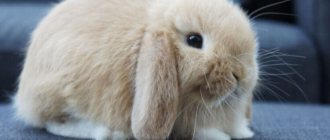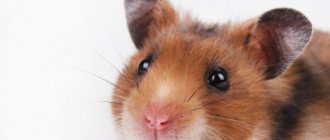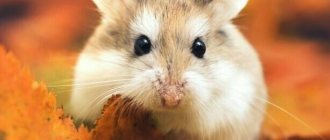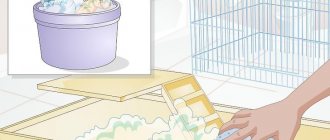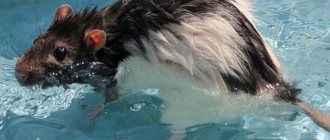Very often in my practice I came across a situation where parents tried to buy a rabbit from me for their children. Like, like a child’s first animal.
Or not the first. Anything happened.
Another question: “Is it necessary?!” Still, a child and a rabbit are a controversial topic...
Origin
It is a mistake to believe that the rabbit descended from the hare. Yes, they are very similar, but their relatives are very distant. If you mate a rabbit and a hare, there will be no offspring due to incompatible biological differences. But wild and domestic rabbits can interbreed.
Today there are more than a dozen different species of these animals. But only the European wild rabbit was domesticated. So all breeds of pets take their roots from the animal living in the territory that is now called Spain.
If you believe the researchers of this country, who tell interesting facts about rabbits, then you can find out the following. When the Carthaginians landed in this territory, the soldiers began to shout: “Span, span!” Such a cry was heard because rabbits were jumping out from under every bush. "Span" means "rabbit" in Carthaginian. That’s why they called the landing place Spain, which means “country of rabbits.”
Acquaintance
Before placing a new rabbit with an old one, the new rabbit must be thoroughly examined by a doctor. This quarantine may take a couple of weeks, but it is necessary. Especially if you took a rabbit from a pet store, from a frivolous breeder, or from an abandoned breeder, it is important to protect the old rabbit from possible infectious diseases.
Do not place a new rabbit's cage in another rabbit's territory. Choose a neutral location. On neutral territory it is necessary to place several shelters with two exits. If a rabbit of lower rank hid in a house with one exit, and an alpha rabbit headed towards the same house, then the submissive rabbit should instinctively step back and make room for the higher-ranking one.
If there is only one way out of the house, then the rabbit with the lowest rank has only one opportunity - to move towards the rabbit with the highest rank. The alpha rabbit instinctively interprets this gesture as an attack. Often such houses with one exit became the site of very brutal fights.
Under no circumstances should rabbits see (or smell) each other before introducing each other! Separating rabbits with a cage is the biggest mistake you can make before meeting them.
For both rabbits, the scent of the enemy means stress, especially for the “master” rabbit, because another rabbit has invaded its territory. Thus, in the rabbits who see each other, but cannot establish a hierarchy, indignation is collected all this time, which will spill out with double force in the form of a brutal fight when you release two rabbits at each other.
So, you have prepared everything and released the rabbits. Place as many greens, vegetables, and hay as possible in different corners to help keep your rabbits distracted and calm while eating.
You can pet your rabbits one at a time to calm them down. If the newcomer smells the same as the “master” rabbit, this will not in any way affect their attitude towards each other, contrary to all the rumors. Therefore, wiping a new rabbit with the fur of the “owner” rabbit is completely useless.
Options for the development of events during dating
- Love at first sight: often occurs between two baby rabbits or between a male and a new female
- Friendship: if there are no conflicts or fights between them, you can leave them together while still being close. But do not leave them alone without your presence, especially if one of them is a teenager (he may at any time try to challenge the dominant position of the older rabbit)
- They climb on top of each other: This is completely normal behavior on the part of both the female and the male.
- They constantly chase each other, run after each other, fur flies: also completely normal behavior. Rabbits lose fur due to stress. Of course, rabbits can also cling to each other and pull out fur. Don't interfere! Let them figure it out themselves.
- Rabbits fight: the “master” rabbit chases the newcomer and at the same time the newcomer does not yield and attacks. This is absolutely normal! Refrain from any interference!
- They ignore each other
- One of them constantly tries to escape the conflict and hides
Even if the clashes seem cruel to you, show maximum perseverance! A huge mistake you can make is pity. Rabbits are not always tender and fluffy. It is their nature to establish a hierarchy in this way. If you start screaming and separating them, you will deprive the rabbits of the opportunity to establish a hierarchy among themselves. As soon as you release them again, everything will start all over again and the first meeting will be in vain!
Remember: only if the rabbit starts squeaking will you see blood or the rabbits are rolling around in a ball, clinging to each other, growling (danger of being bitten in the neck) - only then do the rabbits need to be separated!
These are the only three indicators that will give you an accurate signal that the meeting should be terminated. Use gloves for this. If the rabbits go into a rage, then you may get it too. Two bunnies rolling around in a ball can be separated by clapping or shouting loudly. Rabbits instinctively react to such disturbances. For the best result, the rabbits should be left (under your supervision) to sort things out as long as they need it. Therefore, it is quite possible that you will have to spend your whole weekend getting to know the rabbits or even take a vacation.
If the rabbits no longer show aggression towards each other, the newcomer can be placed in the enclosure with the “master” rabbit. Before doing this, you should clean its area with water mixed with vinegar. It is quite possible that he will begin to race the newcomer again on his territory. Maybe it's the other way around. Here, follow the same rules as on neutral territory - no interference unless there is a squeak and blood. Only when both rabbits lie calmly next to each other, eat together from the same bowl, and clean each other’s fur, can the acquaintance be considered successfully completed. Sometimes days, sometimes weeks and even months pass until this moment.
Lifespan
The better the conditions in which a pet is kept, the longer it lives. Unfortunately, in the wild, a rabbit lives a maximum of three years. It's all to blame:
- illness;
- predators;
- bad weather.
Pets raised for gastronomic purposes live up to two years. They are then killed for meat, and the skins are used to make fur products or souvenirs.
Only decorative rabbits can boast of longevity. They live 7-10 years, some individuals are 13-14 years old. The longest living rabbit died at the age of 19.
The life expectancy of single rabbits is shorter than that of a pair. In freedom, the animals get along as a family.
How to choose
When buying a rabbit, you need to choose the right animal so that there are no problems with it in the future. A healthy animal has no external defects, it is active and inquisitive, and does not show aggression. In addition, it is unacceptable to buy an animal that does not have a pedigree and documents on vaccination and treatment for worms. It is necessary to choose rabbits aged from one and a half months, since they already correspond to the exterior of the breed, and there will be no difficulties in distinguishing a decorative rabbit from an ordinary one.
Sounds
Rabbits can be said to be almost mute creatures. They occasionally make some sounds. Sometimes you can hear a soft clicking of teeth or something similar to rumbling. This means that the animal feels good, like a cat when it purrs. Loud cries indicate pain.
An interesting fact about domestic rabbits is that they sometimes mumble. Such sounds are most often made by a female rabbit when she feeds her offspring.
Running and jumping
Eared pets take part in racing competitions at the rabbit racetrack. After all, they can reach speeds of up to 55 km/h. The animal is motivated by yummy food, and if a predator chases after it, the rabbit will easily leave the greyhound behind.
Another interesting fact about rabbits is their speed of movement and jumping. When buying rabbits for your home, you should get a fence for them. It is desirable that it be higher. These eared animals are very flexible and bouncy. The height to which the rabbit jumps reaches one meter, and the length - three.
A frightened rabbit can instantly take off and run wherever its eyes look, knocking over everything in its path that is not standing, lying or walking.
Content Basics
To properly maintain these decorative pets, you need to purchase various items and accessories, as well as learn how to use them correctly.
It is unacceptable to simply bring home a miniature pet and let it wander around the apartment on its own. In this case, both the animal and the household will have problems.
Rabbit house
For a small decorative rabbit, you need to purchase a cage measuring no less than 60 by 80 cm. Install it in the apartment so that direct sunlight does not fall on it and there are no drafts. The corner should not be cold or steam heated. The pet needs comfortable accommodation.
Also read about how to make your own rabbit cage.
A drinking bowl and feeding trough are installed in the house; they should always be clean.
Cleaning for rabbits is necessary regularly to prevent the appearance of an unpleasant odor in the apartment. Periodically carry out a general cleaning of the cage.
It is better not to use chemical disinfectants, so as not to poison the baby, but to use warm water and vinegar.
Thermal mode
Overheating and hypothermia of this pet are unacceptable.
The optimal temperature for living in an apartment or house is +18…+20°C.
The room should be ventilated daily to prevent high humidity, stagnant air and musty smell.
In the hot season, rabbits are prone to overheating; you can reduce it and help your pets by wrapping their ears with a cloth moistened with cool water. Large vessels responsible for thermoregulation of the entire body pass through here.
Hygiene
In a cage for a decorative rabbit, a tray with natural filling is usually installed - soft shavings, sawdust, wood chip pellets. It should be changed as it gets dirty, preferably daily. This pet is highly clean and will not use anything dirty.
If there is no toilet, you will have to frequently change the hay and bedding.
Mr. Tail recommends: walking
A decorative rabbit cannot be kept in a cage all the time. It is advisable to let him out every day under strict human supervision to walk around the apartment or one room for at least 30 minutes. At this time, you need to make sure that he does not chew furniture or wires, and remove all dangerous objects and chemicals from the access area. The cage door should not be closed so that the rabbit can return to the house at any time.
In the summer, at the dacha, you can make a small enclosure on the grass, providing it with a room in the shade where the pet can hide from direct sunlight.
Records
These cute animals have given the whole world many funny, surprising and interesting results.
Among them are records:
- The longest ears are on a rabbit named Nippers Geronimo - 79 cm.
- The heaviest rabbit is 25 kg.
- The smallest, weighing 350 grams, is the Little Idaho rabbit. Its length does not exceed 35 cm.
- One female produced 24 rabbits.
All these interesting facts about decorative rabbits are recorded in the Guinness Book of Records.
Classification
All decorative rabbits are divided into several subcategories, according to which it is easy to choose the animal you like.
By size they are divided into:
- small;
- average;
- large.
According to the length of the coat there are:
- short-haired;
- normal-haired;
- long-haired.
Let's look at the most popular breeds for home keeping, their characteristics, care features and interesting facts.
Pet breeding
A rabbit suffering from depression may have a false pregnancy, eat a lot and act cocky.
A real pregnancy lasts 30 days. An interesting fact about rabbits is that a female can become pregnant at different times from two different males and carry both offspring at the same time.
The structure of the reproductive organs of a female rabbit is different in that the uterus has two chambers that can store fruits inside themselves independently of each other. The mother feeds her cubs no more than 5 minutes a day.
Mating
The mating of decorative rabbits should be timed to coincide with the female entering the heat.
The frequency of this phenomenon is 6-12 days. But in indoor rabbits, especially dwarf rabbits, their drive is often reduced and this may happen less frequently. A hungry rabbit may become restless and lose her appetite from excitement. If you stroke her back, she will lie down and raise her tail. Due to the rush of blood, the rabbit's genitals may change color from pink to red. Sometimes females, especially those who have given birth, begin to build a nest in the heat: they drag hay into a secluded corner, pluck fluff from the tummy and insulate the future “nursery” with it. Alas, these signs are not always fully manifested. The female goes on a date with the male, you can’t do the opposite. The male should be in an environment familiar to him. The best time for a rendezvous is early in the morning. There should be no traumatic objects in the cage, enclosure or room: in the heat of passion, animals can get hurt. Theoretically, three minutes is enough for a male to mate with a partner. In practice, it may take a couple of hours: not every lady will immediately let her gentleman in, and the libido of dwarf and decorative rabbits is lower than that of “full-size” ones. The progress of mating must be monitored. Sometimes a couple does not find mutual understanding and they need to be seated to avoid injury. If mutual sympathy has arisen, the end of the mating process is indicated by the rabbit “falling off” away from the partner with a quiet squeak in exhaustion.
Mating of decorative rabbits does not always result in pregnancy. Unfortunately, infertility is common among breeds bred with a minimal gene pool. If the female has become calm, her appetite has improved, she is trying to build a nest - with a high probability she has laid eggs. In a pregnant female, the back of the abdomen becomes slightly denser due to the filling of the uterus with fluid. Sometimes a so-called false pregnancy occurs. After mating, the female rabbit behaves like a pregnant female, even the mammary glands begin to function. False pregnancy lasts up to 18 days. A fairly accurate diagnostic method is palpation. After a week, the embryos can be felt in the female’s tummy like small peas. Palpation can only be done with experience. A veterinarian or an experienced rabbit breeder can show you how this is done.
If you are sure that conception has not occurred, the date can be repeated in a few days.
Emotions
Rabbits make different sounds, you can hear:
- grunting;
- whining;
- growl;
- loud grinding of teeth.
This indicates irritation, dissatisfaction or malaise. If you frighten a pregnant rabbit, she may lose her offspring. As for the male, he will simply die of fear, and this is not an exaggeration. Signs of fear:
- eye rolling;
- growl;
- loss of appetite;
- stamping feet.
So it's better to be kinder to them. Under natural conditions, all predators are taller than lagomorphs, so lifting an eared animal upward can greatly frighten it.
Diseases and prevention
The usual life expectancy of decorative breed rabbits is about 7-8 years.
Proper care, regular and nutritious feeding, and attentive attention to your pet will help prolong its life and make its stay in the house joyful.
Any inappropriate, atypical behavior for a rabbit, loss of appetite or complete refusal to eat cannot be ignored; you should immediately contact a veterinarian if you suspect a disease.
Most often, decorative rabbits suffer from the following pathologies:
- stomatitis;
- conjunctivitis;
- rhinitis;
- acute respiratory infections and pneumonia;
- staphylococcosis;
- pasteurellosis;
- coccidosis;
- myxomatosis;
- gastrointestinal disorders - diarrhea and constipation.
Read more about rabbit diseases on our portal here.
Regular deworming (preferably once every three months), treatment for external parasites and vaccination can improve the standard of living of rabbits.
Mandatory vaccinations for rabbits include the following, which protect pets from diseases:
- rabies;
- salmonellosis;
- myxomatosis;
- viral hemorrhagic fever (VHF).
Usually the first vaccine is administered at the age of 6 weeks, but in the event of an outbreak of a disease in the region, it is also possible to vaccinate one-month-old babies. After 3 months, revaccination is carried out, then it is repeated every six months.
It is not advisable to vaccinate lactating females and pregnant rabbits. After vaccinations, the rabbits are kept in quarantine for two weeks.
How to pick up
This is especially useful for children. An interesting fact about rabbits is that any careless gesture is perceived almost as an attack. It is better not to pick up your pet at first.
Let the coward get used to it and get used to it. What to do:
- Handle carefully. The animal's bones are very fragile and can be broken.
- You can't lift him by the ears - it hurts.
- You shouldn't grab him by the withers either. The rabbit may start to struggle and injure its neck.
It is best to hold the furry creature in one hand and hold it with the other.
There are many different breeds of rabbits, but the Angora is especially popular.
What to feed your pet rabbit?
Rabbits do best on grass hay, such as oats or garden grass; Avoid cinnamon hay. Additionally, rabbits need green leafy vegetables; These are lettuce (except iceberg), greens, watercress, carrot tops, cucumbers and sprouts. Feed other vegetables and fruits in moderation, and make sure whatever you offer is safe for rabbits.
You can feed your rabbit commercial food, but feed it in limited quantities as it can interfere with digestion. Feeds containing dried corn or nut ingredients should be avoided.
One of the biggest threats to a rabbit's health is a blockage in the digestive system, and water is essential to normalize the digestion process. Your rabbit should always have plenty of cool, clean, non-chlorinated water.
Angora rabbit
This group of breeds is distributed throughout Europe. The city of Angora in Turkey is considered to be its homeland. There is an opinion that sailors took these furry creatures with them, which is why Angora rabbits spread to different parts of the planet.
Interesting facts about these cuties:
- The length of the coat can reach 25 centimeters. This makes the animal seem much larger, although in fact this group of breeds is considered dwarf. And their weight ranges from two to seven kilograms.
- Russian scientists have developed a downy breed of rabbits. They are able to survive in harsh frosty conditions.
- There are English, Satin, French, Giant, German and Down rabbits. They are all different in some way. German ones bring a large amount of fluff (about 1.5 kg per animal per year). The English breed is considered the smallest, its weight does not exceed three kilograms.
- Angora rabbits are most often found white, but there are other colors (black, gray and with a bluish tint).
China is the leader in the production of Angora rabbit fur. The state produces almost eight thousand tons of fur per year. For such a volume you will need almost 11 million furry animals. But on one continent in the Southern Hemisphere, rabbits are a disaster.
Dwarf rabbit - care and maintenance
For a full life, this animal needs the creation of suitable conditions. Newbie owners are interested in what a dwarf rabbit needs to be comfortable. These include the following points:
- purchasing a spacious cage;
- daily care;
- properly formulated diet.
Caring for a Dwarf Rabbit
When purchasing a pet, everyone wants it to stay with the family for as long as possible, so it is important to know how to care for dwarf rabbits. In order for your animal to enjoy good health for many years, you need to follow certain recommendations:
- Keep your eyes, ears and genitals clean.
- In case of contamination with feces, the animal must be washed immediately.
- Regularly monitor the condition of your dwarf rabbit's teeth.
- Trim nails every month using a nail clipper.
- Brush the fur once a week.
Cage for dwarf rabbit
The size of the house for a furry pet must exceed 70 cm in length; it is filled following certain rules:
- Place in a place protected from drafts and cold.
- A layer of hay or sawdust is placed at the bottom, its layer is from 3 to 5 cm. It is recommended to change it every week.
- The tray is placed in the corner opposite from the resting place. Beginner owners are interested in how to train a dwarf rabbit to use a litter tray. Everything is very simple: the container must contain filler that is pleasant to the animal and is not used as bedding. You need to put the rabbit in the tray more often, and you can also collect the droppings and put them in the designated place.
- The feeder is ceramic; due to its heaviness, the rabbit will not be able to turn it over.
- Fresh water must be constantly available. An automatic drinker with a ball is ideal for this.
- A rest house is placed in the far corner.
- The Dutch dwarf rabbit and other breeds are sensitive to stuffiness and overheating. The optimal room temperature for them is +18…+20ºС.
What to feed a dwarf rabbit?
Babies are endowed with certain features of the digestive system, which you need to become familiar with before creating a diet for them. A single-chamber stomach and high digestion speed lead to the fact that they eat up to 30 times a day. Angora dwarf rabbits and other breeds need to include the following products in their diet:
- hay;
- fresh grass;
- twigs with bark and leaves;
- grains: oats, barley;
- soaked legumes;
- boiled and raw vegetables;
- fresh fruit.
Feed is given in quantities of no more than 3 tbsp. spoons per day. The diet should contain: bone meal, mineral stone or pressed chalk. The following are prohibited:
- henbane;
- buttercups;
- sweet mixtures;
- dried fruits;
- spicy;
- salty.
Diseases of dwarf rabbits
These animals are susceptible to many diseases. A veterinarian must understand them and prescribe the correct treatment. Among the main diseases are the following:
- Viral hemorrhagic disease
. Children from two months to six years are affected. They become infected from sick animals or through objects they have used. Once infected, the mortality rate is 90%; there is no treatment. You can keep your pet safe by vaccinating your dwarf rabbits. The vaccine protects them for up to 15 months. - Gastrointestinal stasis
. Slowing or complete cessation of peristalsis occurs as a result of stress, pain or lack of hay in the diet. The problem can be determined by the absence of feces and a rumbling tummy. Apart from this, the rabbit does not eat anything and practically does not move. Treatment includes massage, enemas and medications. - Urinary dermatitis
. Symptoms: hair loss on the hind legs or in the genital area. The affected area is washed. Subsequently, steroid drugs are prescribed. - Coccidiosis
. Infection with parasites through feces. Weakness, diarrhea, and bloating are observed. Death can occur after 10 days. The treatment is determined by the veterinarian. Even after recovery, the animal remains infectious to others. - Myxomatosis
. Transmitted through fleas, lice and other parasites. The dwarf rabbit refuses to eat. Later, swelling of the eyelids and suppuration of the eyes occurs. There is no treatment; after a week of suffering, the animal dies. It is important to get vaccinated on time.
Rabbits in Australia
Due to their fertility and the absence of enemies in their natural environment, rabbits have spread throughout the Australian continent. These animals brazenly increased their habitat to 100 km per year. In order to somehow stop the land grab by eared animals, the Australians created the Great Barrier - a wire fence, the length of which was 3,500 kilometers.
But it didn’t work, the animals dug under the fence and spread further, getting on the nerves of farmers, destroying crops and vegetation. In the middle of the 20th century, the rabbit population amounted to 750 million.
As soon as they fought with rabbits in Australia. Interesting facts indicate that even predators that were specially brought to the continent could not cope with this task:
- foxes;
- martens;
- caresses;
- dogs;
- ferrets.
These animals preferred to hunt marsupials, and rabbits both spread and continue to spread, threatening to wipe out sheep farming in the country.
Eared animals were poisoned with chemicals, but this did not give much results. An effective remedy was infecting specially bred mosquitoes with an infectious disease, which led to the death of almost 90% of the rabbits. But the surviving animals gained immunity and continued to reproduce.
Today, the fight against the eared scourge continues. Every year, these cuties eat enough grass to feed 25 million sheep.
Guys about animals
Children usually want to have a furry friend at home. Often the choice falls on cute eared animals.
After watching them, you can note some interesting facts about rabbits for children:
- baby rabbits are born with their eyes closed and without fur;
- A rabbit has 28 teeth, they grow constantly throughout his life;
- the animal has 5 fingers on the forelimbs and 4 on the hind limbs;
- the heaviest rabbits weigh more than 25 kg;
- the rabbit's eyes are designed so that he does not need to turn his head to view the area;
- Only the animals’ paws sweat, so in the summer they can overheat;
- in a minute, a rabbit is able to make 120 chewing movements and has more than 17,000 taste buds;
- if, when the owner appears, the rabbit rises on its hind legs, it means that he recognized him;
- an eared baby weighing 2 kg drinks the same amount of water as a dog weighing 10 kg;
- Rabbits' mustaches grow near the nose and around the circumference of the face, which helps determine the distance to an obstacle in the dark and go around it;
- long-eared pets mark their territory with their chin, they rub it against objects, leaving a secretion with a specific smell;
- the female, before giving birth, builds a nest from her wool plucked from the breast;
- a medium-sized animal can eat enough grass to fill a pillow;
- your pet should not be bathed, rabbits are clean and lick their fur 5-6 times a day, and an unpleasant odor can only indicate that the animal is sick;
- lagomorphs distinguish only red and green colors and their shades.
When purchasing a fluffy lop-eared animal for home, you should weigh everything carefully. After all, feeding, maintaining and caring for an animal will require certain costs and time. It is worth approaching this issue responsibly so that the owners and the pet itself do not suffer later.
How to choose decorative rabbits?
Hermelin
Today there are many different breeds of animals that are chosen for home keeping. And you need to decide before purchasing what kind of rabbit you want to have at home.
Among the most popular breeds are:
- Hermelin;
- Colored dwarfs;
- Lop-eared, they are also called rams;
- Dwarf rabbits "Fox";
- Angora rabbits;
- Rex;
Garmelins are rabbits with blue and red eyes, and the fur of such animals is white. They are distinguished by a fairly large head and wool - thick and short, the weight of the animals does not exceed one and a half kilograms.
At the same time, there are characteristics of the breed depending on the sex of the animal. Males are calm and friendly, but females are somewhat nervous in character, and in some cases even aggressive.
Colored dwarfs are a breed distinguished by the presence of erect ears. Rabbits weigh up to one and a half kilograms. They vary in color from white-haired to red and black-fiery.
This breed can also be varied in character - affectionate, friendly, but at the same time they are not alien to bursts of aggression. Aggression is especially common during puberty.
Such rabbits are an exception to the general rule - they have short hair, so they do not need to be combed. But at the same time, they really love it when their cheeks or forehead are scratched in the area between the ears.
Fold-eared babies are slightly larger than dwarf breeds. They weigh up to 2 kg. Their ears hang down, giving the impression that they have a peaceful and calm nature.
These rabbits love to eat. And the ears at the bottom drop gradually - until they are 4 weeks old. These rabbits are friendly and peaceful.
Fox rabbits have smooth, long hair. Their weight is standard - up to one and a half kg. Rabbits got their name because of their fur - it is strong and thick, and can reach up to 7 cm in length.
The color of such breeds is varied - white, blue, red, etc. They can be unique in character - both kind and aggressive. Foxy rabbits definitely need to be combed.
Angora babies have thick hair, both on the body and on the face. Their wool is often compared to down - it is soft and very thin. They often even resemble small dogs in appearance. Animals weigh up to one and a half kilograms. The character is varied.
Rex is a short-haired breed, characterized by short hair that is velvety to the touch. When these animals are small, they are even called ugly. However, with age they turn into real beauties. By nature, the breed is completely calm and does not show aggression.
